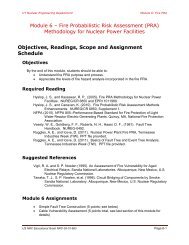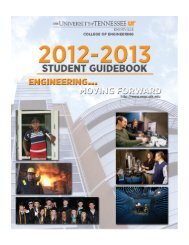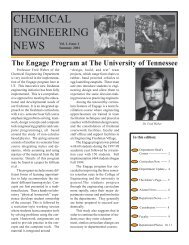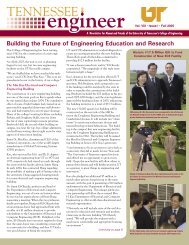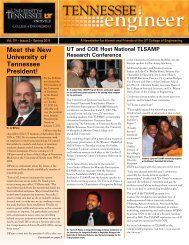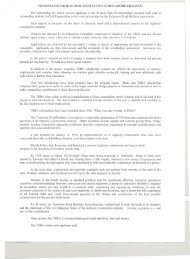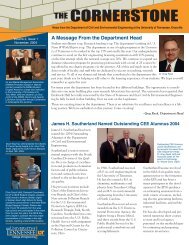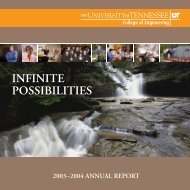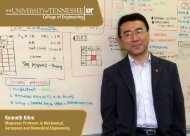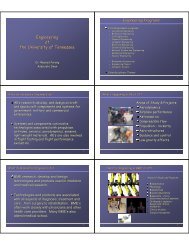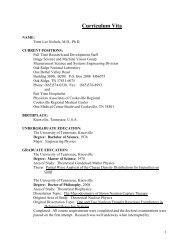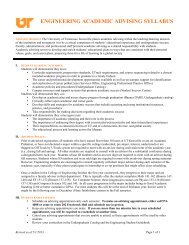CBE 2009 Annual Report - College of Engineering - The University ...
CBE 2009 Annual Report - College of Engineering - The University ...
CBE 2009 Annual Report - College of Engineering - The University ...
You also want an ePaper? Increase the reach of your titles
YUMPU automatically turns print PDFs into web optimized ePapers that Google loves.
Outstanding Alumnus Jerry Johnson<br />
Although Jerry L. Johnson has made the unusual<br />
transition from engineering to finance, he still<br />
values the lessons that he learned as a chemical<br />
engineering major at the <strong>University</strong> <strong>of</strong> Tennessee.<br />
Johnson was born in Atmore, Alabama, and lived<br />
in the state until he was in the 9th grade, when<br />
his family moved to Columbia, Mississippi. After<br />
graduating from high school, Johnson decided to<br />
continue his education at UT.<br />
“<strong>The</strong> largest contributing factor to my selecting the<br />
<strong>University</strong> <strong>of</strong> Tennessee for college was the Minority<br />
<strong>Engineering</strong> Scholarship Program (MESP). This<br />
program provided an excellent opportunity to gain<br />
valuable work experience and attain a world-class<br />
engineering education. Additionally, the program<br />
was key to funding my education through a paid<br />
position and an academic scholarship,” Johnson said.<br />
Johnson was exposed to engineering design and<br />
operations at an early age through his brother’s<br />
work in the upstream oil and gas business for<br />
Exxon. Johnson was fascinated by chemical<br />
engineering because it involves operations,<br />
research, business and management. He hoped<br />
to be exposed to a variety <strong>of</strong> disciplines through a<br />
single major.<br />
“<strong>The</strong> university provided<br />
an amazing environment<br />
that fostered learning<br />
and fun,” Johnson added.<br />
“I still maintain a very<br />
close relationship with<br />
several <strong>of</strong> the pr<strong>of</strong>essors<br />
and staff members who<br />
were at UT during the<br />
time I was working on<br />
my degree.”<br />
During his time at UT,<br />
Johnson served as the<br />
president <strong>of</strong> Tau Beta Pi<br />
<strong>Engineering</strong> Honor Society and also volunteered on<br />
weekends at the Ronald McDonald House.<br />
After receiving his bachelor <strong>of</strong> science in chemical<br />
engineering, summa cum laude, in 1994, Johnson<br />
accepted a position with McKinsey and Company<br />
in Atlanta, Georgia. McKinsey serves as an advisor<br />
company to the world’s largest businesses,<br />
governments and institutions. His experience<br />
at McKinsey provided him with an opportunity<br />
to work with Fortune 500 CEOs in a variety <strong>of</strong><br />
“<strong>The</strong> university<br />
provided an amazing<br />
environment that<br />
fostered learning<br />
and fun”<br />
industries on an international scale. It was Johnson’s<br />
first introduction to principal investing, corporate<br />
strategy and foreign policy.<br />
Johnson received his M.B.A. from Harvard Business<br />
School (HBS) in 1998. During his time at Harvard, he<br />
led a year-long project with his fellow students to<br />
devise a strategy for BancBoston Capital to invest<br />
over $100 million in growing domestic markets.<br />
Following HBS, Johnson entered Wall Street to work<br />
with Donald, Lufkin and Jenrette.<br />
In 2004, Johnson was<br />
appointed by President<br />
George W. Bush as a<br />
White House Fellow<br />
to serve as a special<br />
assistant to then-<br />
Secretary <strong>of</strong> Defense<br />
Donald Rumsfeld.<br />
“<strong>The</strong> White House<br />
Fellowship was a<br />
unique opportunity<br />
to participate in<br />
government, working<br />
directly with a cabinet<br />
member,” Johnson<br />
recalled. “Additionally, I had the opportunity to<br />
participate in an education program consisting<br />
<strong>of</strong> roundtable discussions with renowned leaders<br />
from the private and public sector, and trips to<br />
study U.S. policy in action both domestically and<br />
internationally.<br />
Johnson was awarded the Secretary <strong>of</strong> Defense<br />
Medal for Exceptional Public Service for his work on<br />
the Quadrennial Defense Review during his years as<br />
a White House Fellow.<br />
In 2007, Johnson joined RLJ Equity Partners as<br />
vice president. <strong>The</strong> company is a private equity<br />
enterprise founded by billionaire businessman<br />
Robert L. Johnson and the Carlyle Group. RLJ<br />
Private Equity acquires control positions in<br />
companies with enterprise values between<br />
$75 and $300 million. <strong>The</strong> firm invests in a<br />
broad range <strong>of</strong> sectors, including business and<br />
government services, transportation and media.<br />
“<strong>The</strong> key factor that led me to accept the<br />
position at RLJ was the opportunity to be a part<br />
<strong>of</strong> the founding team <strong>of</strong> an asset management<br />
firm. Since I joined the firm, we have raised over<br />
$225 million in capital, established a world-class<br />
investment team, and we are actively deploying<br />
capital,” Johnson said.<br />
Although not directly involved in engineering<br />
on a day-to-day basis, Johnson believes his<br />
degree has given him a unique base for his<br />
current position.<br />
“In my opinion, engineering is a way <strong>of</strong> thinking.<br />
My engineering degree provided a strong<br />
foundation that allows me to think analytically<br />
about any problem,” Johnson commented.<br />
He also enjoys spending time with his family.<br />
His wife, Cara Grayer Johnson, is an attorney<br />
in the International Bureau <strong>of</strong> the Federal<br />
Communication Commission and an accessory<br />
designer specializing in sustainable fashion. <strong>The</strong><br />
couple has an 18-month-old daughter, Cayden-<br />
Rose, and reside in Washington, D.C.<br />
Renowned Lecturers Dr. G. M. Homsy & Dr. Ronald Larson<br />
<strong>The</strong> Department <strong>of</strong> Chemical and Biomolecular <strong>Engineering</strong> hosted two<br />
<strong>College</strong> <strong>of</strong> <strong>Engineering</strong> Distinguished Lectures during the 2008 – <strong>2009</strong> academic year.<br />
Dr. G. M. Homsy<br />
On November 14, 2008. Dr. George M. “Bud”<br />
Homsy, pr<strong>of</strong>essor from the Department <strong>of</strong><br />
Mechanical <strong>Engineering</strong>, <strong>University</strong> <strong>of</strong> California-<br />
Santa Barbara, spoke on “Interfacial Fluid<br />
Mechanics: New Twists on an Old Subject.”<br />
Homsy discussed the effect <strong>of</strong> chemical<br />
reactions on fingering, spontaneous chemically<br />
driven tip-streaming <strong>of</strong> drops, chaotic advection<br />
driven by interfacial electrical stresses and<br />
enhanced heat and mass transport in chaotically<br />
stirred drops. He also covered the fascinating,<br />
counter-intuitive and unexpected phenomena<br />
that continue to be discovered in the study <strong>of</strong><br />
fluid flows driven by the forces associated with<br />
the presence <strong>of</strong> an interface.<br />
Dr. Ronald G. Larson<br />
Dr. Ronald G. Larson presented “Micr<strong>of</strong>luidic<br />
Methods for Manipulating Biopolymers” on<br />
April 7, <strong>2009</strong>. He discussed how he and his<br />
colleagues develop micr<strong>of</strong>luidic methods for<br />
manipulating biopolymers. <strong>The</strong>se include<br />
imaging and breaking down single DNA<br />
strands and proteins using what is known as a<br />
flow field surface.<br />
This is an important concept in the development<br />
<strong>of</strong> micr<strong>of</strong>luidic devices for processing DNA and<br />
also helping to understand how certain proteins<br />
interact with DNA in cellular processes, such<br />
as DNA repair and copying. Using these new<br />
methods, Dr. Larson is exploring ways to unravel<br />
the DNA code through a “manipulation flow,” then<br />
apply the analysis <strong>of</strong> DNA-protein interactions to<br />
help prevent viruses from spreading.<br />
10 11




